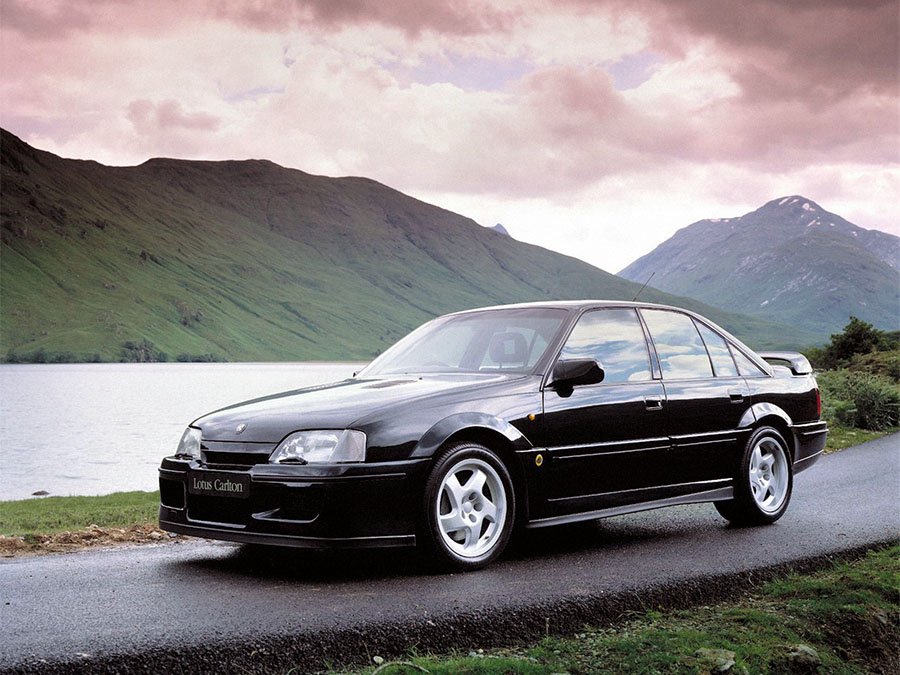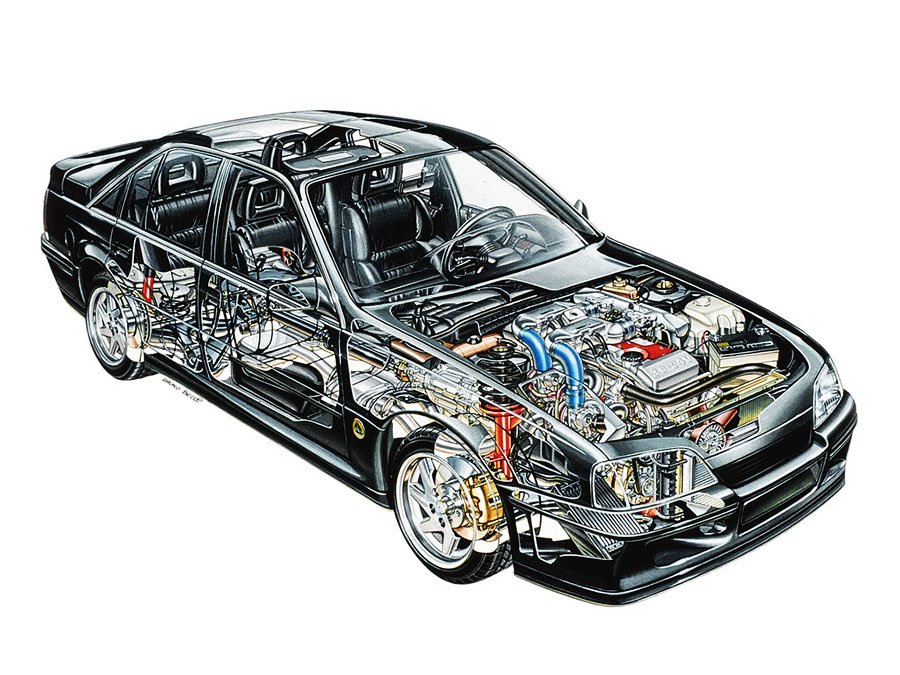Guide: Lotus Carlton / Omega
Background
Soon after General Motors acquired Lotus in 1986, executives from the two organisations decided to embark on a mutually beneficial image-building project. The plan was to create a machine similar to the highly successful Lotus Cortina of the 1960s.
The Lotus Cortina had been conceived as a homologation special for Group 2 touring car racing. It was powered by the trick dual overhead camshaft motor that Lotus had developed out of Ford’s Kent engine. Thanks to its iconic looks, exciting light weight high performance specification and enormously successful competition record, the Lotus Cortina went down as one of the most iconic saloon cars of its era.
For this latest collaboration, Lotus would deliver the fastest four door production car ever offered to the public.
The new model, internally dubbed Lotus Type 104, would be based on the current Vauxhall Carlton / Opel Omega
General Motors had acquired the British Vauxhall concern in 1925. 80% of German firm Opel was then purchased in 1929, followed by the remaining 20% in 1931.
During the 1970s and 1980s, the Vauxhall and Opel offerings were rationalised into one consistent range across Europe. Thereafter, the Vauxhall badge was used in the United Kingdom with Opel branding almost everywhere else.
Having assessed GM’s current line up of Vauxhall / Opel models, Lotus decided to base the Type 104 on the Carlton Mk2 / Omega A platform that had been launched in 1986.
At the head of the Carlton / Omega range was the straight six-powered GSi 3000 which, since October 1989, was offered with a dual overhead camshaft 24 valve engine.
Each base car was delivered to the Lotus factory in Hethel as a standard GSi 3000 24v. Then the time-consuming transformation began.
To start, the suspension, engine, glass and interior were stripped out. The bodyshell was then modified with cutaways to accommodate a brawny body kit and beefed up transmission. Engines were sent away to be comprehensively uprated; they returned in 3.6-litre twin turbocharged configuration and were coupled to a six-speed ZF ‘box.
After a prototype was displayed at the Geneva Motor Show in March 1989, production of the Lotus Carlton / Omega started in September 1990. General Motors originally hoped to complete a run of 1100 cars.
Chassis
The Carlton Mk2 / Omega A was based around a galvanised steel bodyshell with 2730mm wheelbase (the latest iteration of General Motors’ V platform).
Fully independent multi-link suspension was fitted all round.
Up front was a MacPherson strut arrangement while the back end utilised a multi-link axle with semi-trailing arms. To improve high speed stability and handling, Lotus dropped the ride height, fitted stiffer coil springs, uprated gas-filled dampers, thicker anti-roll bars and self-levelling rear suspension from the Senator.
Servotronic speed-sensitive power-steering was also imported from the Senator.
The brake system was enhanced with enormous 330mm ventilated front discs and four-piston AP calipers. Solid 300mm discs with twin-piston AP calipers were fitted at the rear. ABS was standard.
Although the prototype displayed at Geneva in 1989 was presented on split rim wheels, production cars used single piece forged alloys manufactured by Ronal. The handsome 17-inch diameter rims measured 8.5-inches wide at the front, 9.5-inches wide at the rear and originally came shod with Goodyear Eagle tyres.
As usual, a 75-litre fuel tank was installed underneath the trunk floor.
Engine / Gearbox
In standard trim, the longitudinally mounted Type C30 SE straight six engine fitted to the GSi 3000 24v displaced 2969cc. It came with wet-sump lubrication, a cast-iron block, a light alloy DOHC head with four valves per cylinder, a 10.0:1 compression ration and Bosch Motronic engine management.
Peak output was 201bhp at 6000rpm and 199lb-ft at 3000rpm.
Customers could order a five-speed manual or four-speed automatic gearbox.
The Type C36GET engine developed by Lotus featured a host of enhancements. The block was strengthened with reinforced webbing, there was a new forged steel crankshaft and special Mahle pistons with custom connecting rods. The re-ported head was milled to reduce the static compression ratio (which dropped to 8.2:1).
As per the GSi 3000 24v, cylinder bore was kept at 95mm. However, by extending the stroke from 69.8mm to 85mm, Lotus realised a 646cc gain for an overall capacity of 3615cc.
Two enormous Garret T25 turbochargers set at 0.7 bar were fitted, along with a Behr intercooler. The original ignition system of the GSi engine was replaced with a three-coil wasted spark system. The distributor drive was re-purposed as a water pump drive for the water-air intercooler circuit.
A new Delco engine management system was created specially for this application.
There were also twin thermostatically controlled engine oil coolers and a custom exhaust system.
A pair of three-way catalytic converters ensured the Type 104 complied with all the latest emissions legislation.
As a result of these changes, peak output soared to 377bhp at 5200rpm and 419lb-ft at 4200rpm.
Transmission was through a ZF S6-40 six-speed manual gearbox, a hydraulic single-plate clutch and limited-slip differential.
Bodywork
To enhance the original car’s rather pedestrian bodywork, Lotus developed an aero kit that comprised custom fibreglass bumpers, a rear spoiler and side skirts.
The front bumper featured much bigger air intakes and a deep satin black chin spoiler. The supplementary inlet between the headlights was now partially blanked off. Other cooling solutions included a pair of ventilation louvres on the hood.
Down each flank were custom body coloured mouldings. Like the bumpers, these were integrated with substantial wheelarch extensions. The flush door handles and exterior mirrors were also body coloured.
Lotus badges were added behind the front fenders and on the tailgate.
Compared to the standard GSi, the Lotus Carlton / Omega was 26mm longer, 157mm wider and 33mm lower.
Interior
To add a touch of luxury, the seats, front centre armrest, glovebox insert, gearknob and gear gaiter were upholstered in anthracite Connolly leather. Door panels were a mix of the same anthracite leather and light grey suede with walnut veneer inserts.
A matching walnut insert also shrouded the gear lever.
Much of the leather was heavily ruched.
The four-spoke non-airbag steering wheel was trimmed in black leather. It fronted a soft-touch plastic dash with a full complement of Lotus-branded instrumentation. This comprised large read outs for road and engine speed plus smaller gauges for fuel and water temperature. Digital read outs were also housed in the main binnacle along with an array of warning lights at the base.
The centre console was home to an anologue clock, various rocker switches, the ventilation controls, audio system, ashtray and cigar lighter.
Standard equipment included manually-adjustable heated sports seats, electric heated mirrors, electric windows, air-conditioning, central locking, an electric sunroof, an alarm and immobiliser and high end Blaupunkt audio system.
Green tinted glass was fitted throughout.
Options
No optional extras were offered and only one colour scheme was available: pearlescent Imperial Green with Anthracite upholstery.
Weight / Performance
Although at 1655kg the Lotus Carlton / Omega was a little over 15% heavier than the 3000 GSi, it offered nearly 88% more power which led to some astonishing performance figures.
Top speed went from 146mph to an officially quoted 174mph. However, in excess of 180mph was actually possible. By contrast, other high performance saloons of the era, most of which were produced by the likes of Mercedes-Benz and BMW, were electronically limited to 155mph.
Despite its long gearing (55mph was possible in first), the new Lotus super saloon could hit 62mph from a standstill in just 5.2 seconds. Amazingly, this put it on a par with the likes of the Ferrari Testarossa and Porsche 911 Turbo.
Reception
At the time, the idea of such a fast four-door machine inexplicably caused controversy. In the UK, the famously bourgeois Daily Mail newspaper even started a campaign to have the car banned.
Road testers criticised the car for its heavy clutch and a vagueness to the steering at high speeds. Otherwise though it fully lived up to the hype.
Unfortunately, as a result of the early 1990s recession and limited badge appeal, sales were a slower than expected.
Production Changes
No significant production changes were made although the audio system was changed from the 800th car.
End of Production
Having started in September 1990, production was discontinued in December 1992.
Although General Motors had hoped to sell 1100 units, 950 were ultimately completed.
Of these, 630 were badges as the Lotus Omega and 320 as Lotus Carlton (250 of which were destined for the UK market).
Text copyright: Supercar Nostalgia
Photo copyright: Lotus - https://www.lotuscars.com





































